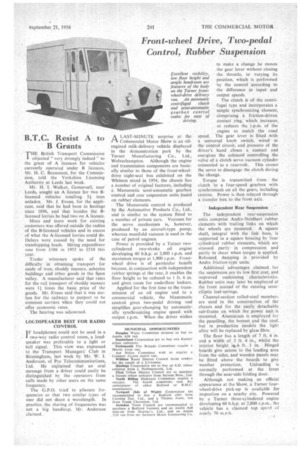Front-wheel Drive, Two-pedal Control, Rubber Suspension
Page 93

If you've noticed an error in this article please click here to report it so we can fix it.
B.T.C. Resist A to B Grants
THE British Transport Commission
objected "very strongly indeed" to the grant of A licences for vehicles currently operated under B licences, Mr. H. C. Beaumont, for the Commission, told the Yorkshire Licensing Authority at Leeds last week.
Mr. H. I. Walker, Gomersall, near Leeds, sought an A licence for two 13licensed vehicles totalling 5i tons unladen. Mr. 1. Evans, for the applicant, said that he had been in haulage since 1896, and that besides the Blicensed lorries he had two on A licence.
More and more work for existing customers was offered outside the radius of the B-licensed vehicles and in excess of what the A-licensed lorries could do. Delays were caused by the need for transhipping loads. Hiring expenditure rose from £1811 in 1955 to 1510 this year.
Trader witnesses spoke of the difficulty in obtaining transport for oxide of iron, shoddy manure, asbestos buildings and other goods in the Spen valley. A manufacturer said that rates for the rail transport of shoddy manure were 11 times the basic price of the goods. Mr. Evans said that it was useless for the railways to purport to be common carriers when they could not offer economic rates.
The hearing was adjourned.
LOUDSPEAKER BEST FOR RADIO CONTROL I F headphones could not be used in a two-way radio control room, a loudspeaker was preferable to a light or bell signal. This view was expressed to the Transport Managers' Club in Birmingham, last week by Mr. W. J. Anderson, of Pye Telecommunications, Ltd. He explained that an oral message from a driver could easily be distinguished by the operators from calls made by other users on the same frequency.
The G.P.O. tried to allocate frequencies so that two similar types of user did not share a wavelength. In practice, the sharing of frequencies was not a big handicap. Mr. Anderson claimed.
A LAST-M1NUTE surprise at the 1-1 Commercial Motor Show is an oilengined milk-delivery vehicle displayed in the demonstration park by the Turner Manufacturing Co., Ltd., Wolverhampton. Although the engine and transmission components are basically similar to those of the front-wheeldrive eight-seat bus exhibited on the Whitson stand in 1954, the chassis has a number of original features, including a Manumatic semi-automatic gearbox control and rear suspension units based on rubber elements.
• The Manumatic control is produced by the Automotive Products Co., Ltd., and is similar to the system fitted to a number of private cars. Vacuum for the servo mechanism is, however, produced by an aircraft-type pump, whereas manifold vacuum is used in the case of petrol engines.
Power is provided by a Turner twocylindered two-stroke oil engine developing 40 b.h.p: at 2,800 r.p.m. and maximum torque at 1,900 r.p.m. Frontwheel drive is of particular benefit because, in conjunction with independent rubber springs at the-rear, it enables the floor height to be reduced to 1 ft. 6 in. and gives room for underfloor lockers.
Applied for the first time to the transmission of an oil engine and to a commercial vehicle, the Manumatic control gives two-pedal driving and simplifies gear-changing by automatic-. ally synchronizing engine speed with output r.p.m. When the driver wishes
to make a change he moves the gear lever without closing the throttle, hr varying its position, which is performed by the control according to the difference in input and output speeds.
The clutch is of the centrifugal type and incorporates a simple synchronizing element, ebmprising a friction-driven contact ring, which increases, or reduces the r.p.m. of the engine to match the road speed. The gear lever is fitted with a universal knob switch, wired in the control circuit, and pressure of the driver's hand closes a contact and energizes the solenoid controlling the valve of a clutch servo vacuum cylinder connected to a reservoir. This causes the servo to disengage the clutch during the change.
Torque is transmitted from the clutch to a four-speed gearbox with synchromesh on all the gears, including reverse. Power is then relayed through a transfer box to the front axle.
Independent Rear Suspension
The independent rear-suspension units comprise Andre-Neidhart rubber elements with trailing links on which the wheels are mounted. A square shaft, integral with the link boss, is supported in a square housing by four • cylindrical rubber elements, which are . stressed partly in compression and partly in shear when torque is applied. Rebound. damping is provided by Andre friction-type units.'
Additional advantages claimed_ for the suspension are its low first cost, and improved cushioning characteristics. Rubber units may later be employed at the front instead of the existing semi'elliptic leaf-springs.
Channel-section rolled-steel members are used in the construction of the chassis and for the easily detachable sub-frame on which the power unit, is mounted. Aluminium is employed for the panelling, the bonnet and the roof, but in production models the light alloy will be replaced by glass fibre.
The floor has a length of 7 ft.. 4 in. and a width of 5 ft. 4 in., whilst the interior height i 6 ft. 1 in. Hinged boards give access to the loading area from the sides, and wooden panels may be fitted above the boards to give weather protection. Unloading is normally performed at the front through the Rear-side folding door.
Although not making an official appearance at the Show, a Turner fourwheel-drive pick-up is available for inspection on a nearby site. Powered by aTurner three-cylindered engine developing 60 b.h.p. at 2,800 r.p.m.. the vehicle has a claimed top specd of nearly 70 m.p.h.




































































































































































































































































































































